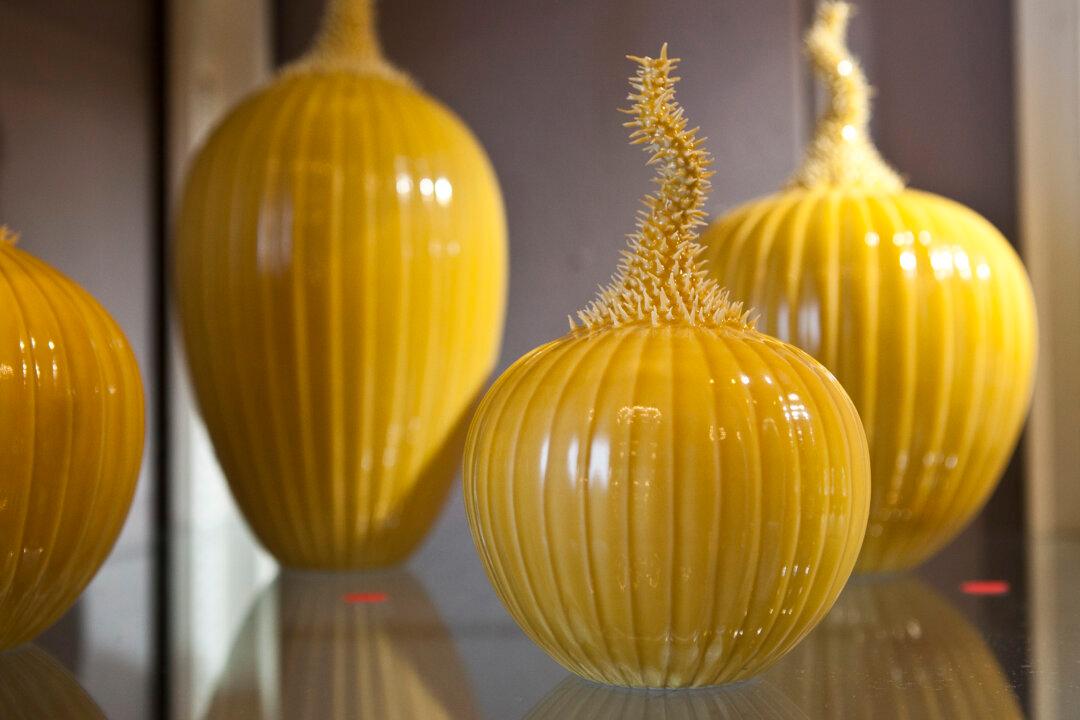NEW YORK—Among the 29 exhibitors who set up shop at The New York Ceramics Fair at the Bohemian National Hall are dealers of English and American antique tableware, ancient pottery, even glass—but the standouts have to be the ceramic artists brimming with knowledge and enthusiasm for their craft.
The booth of Linda and James Haggerty looks like a collection of moon rocks. Experts in glaze chemistry, the couple who hail from Santa Barbara, Calif., have created interesting textures that look like frog’s skin, lunar landscapes, and iridescent glass.
Their studio houses hundreds of glaze ingredients and additives native to California, which lend the couple endless experimentation. James Haggerty said it’s hard to repeat an effect—the same glaze fired with pine added to the kiln can produce an earthy look whereas eucalyptus imparts a stunning olive-gold tone. It all comes down to the chemistry and the amount of oxygen a type of wood consumes as it burns.
John Pagliaro from Shelter Island, N.Y., builds tables from driftwood and glass, wall décor, and paper lanterns all from natural materials. The center of Pagliaro’s display at the fair are his pinch pots—a form that typically gets made as diminutive finger bowls, but which Pagliaro has pushed to the limit. Starting with a dozen pounds of clay, he pinches and shapes the material over the course of 10 days—not so fast that the vessel collapses, and not so slowly that the clay resists further manipulation.
“It’s not an additive or subtractive process,” he said. “It’s just a distributive one. It’s as if over the course of ten days I’m slowly breathing into it until it gets this shape.”
Cliff Lee, who lives in Amish country, Pa. goes the distance for his historical-inspired art. Drawing from museum archives of China’s Song and Ming porcelains, Lee has researched and recreated the iconic glazes—imperial yellow, celadon, and sacrificial red—from those periods.
He goes as far as sleeping at historic kiln sites to study the soil and and native organic materials. While his work retains the tradition and spirit of classic Chinese ceramics, it bears unusual and difficult-to-achieve details like the spines of a gourd or lotus, and the wiry whiskers of a dragon.
Aytek USA sells Turkish rugs and kilims at its store in Carlstadt, N.J., but the company also represents Turkish artists who redesign antique ceramics and tiles from Iznik and Kutahya, two towns with storied histories of ceramic production. Manager Cemal Uzun shows a series of pottery and tiles bearing a coral glaze that very few people know how to produce. Another group of pottery catches the eye with its bright turquoise hue and intricate painted patterns.
“There’s one family that keeps the formula for that blue, and they don’t share it,” Uzun said.
Over the course of the fair, ceramic experts and decorators will hold public lectures. On Saturday, Ron Fuchs II, curator of the Reeves Collections at Washington and Lee University, will discuss pottery with painted scenes that describe their own production. Leslie Ferrin of Ferrin Contemporary will explore the work of contemporary ceramic artists. Lectures are free with admission.
The New York Ceramics Fair 2014
Bohemian National Hall (321 E. 73rd St., Floors 4 & 5)
Jan. 22–26
Admission of $20 includes illustrated color catalogue
www.newyorkceramicsfair.com






